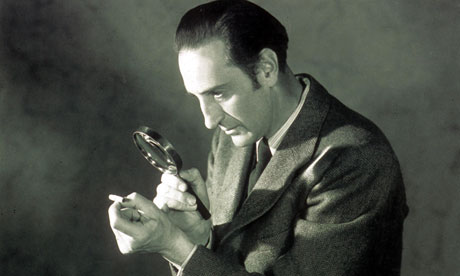
Self-help manuals have always been keen to stress that we can make more of the mental resources available to us (the famous, and wildly incorrect suggestion that we only use 10% of our brains derives from a claim in a self-help book). Maria Konnikova's hope is that by the end of her book, you will improve your more habitual thought processes by automatically asking yourself "what would Sherlock Holmes do and think in this situation?". Holmes is for her an ideal exemplar of both mindful thinking and of expertly trained insight. A tiresome person might point out that, as Holmes was not a real person, at least some of his expertise might arise from his creator knowing the answers to the puzzles Holmes alone can solve. Konnikova, however, says that as amazing feats of insight were achieved by Conan Doyle and some of his contemporaries, we can safely suspend our disbelief. I found this difficult to do.
Daniel Kahneman's Thinking, Fast and Slow delineates between thoughts that are driven by fast, perceptual systems, and slower, more controlled executive processes. Konnikova owes a great debt to this book, and explicitly constructs Kahneman's distinct cognitive systems as "System Watson" and "System Holmes". Unlike Kahneman, she prioritises System Holmes – the slow, controlled processes – while denigrating System Watson as unthinking.
Konnikova's initial example of this is that Holmes knows the number of stairs from the hall to his room at 221B Baker Street, while Watson does not: the more mindful Holmes has paid attention while Watson has always run up them heedlessly. Konnikova identifies this as a key point in her own discovery of psychology, that we could interact with something daily that we in some way do not fully "see". I, however, would argue that it reflects the ways that our unconscious perceptual processes solve the problems of how we manoeuvre around our worlds without conscious involvement: when I encounter a flight of stairs, it is more important that my sensory-motor systems get me up or down them without tripping and falling, than that I know how many there are. Indeed, System Watson gets a rough ride throughout the book: there are many phenomena at which these "automatic" sensory-motor processes excel: they are not fooled by visual illusions as much as conscious processes, for example, and they are more accurate at helping us dance to a beat. If Holmes had appeared on Strictly Come Dancing, one suspects his professional dance partner would be hissing "stop counting" at him all the way through the American Smooth.
Systems Watson and Holmes are used as a framework for discussing concepts in psychology, with examples from the Holmes canon used as evidence. This structure starts to creak under the narrative weight. Holmes's memory of the case of the death of Van Jansen is an important development in A Study in Scarlet: equally important, the policeman Gregson does not recall the case. "Why does Holmes remember Van Jansen and Gregson does not," asks Konnikova. "Because the story would be less mysterious if he did?" answers the reader who is finding it hard to forget that these cases are fiction.
There are more central errors as well: Holmes's concept of a memory attic is taken as a useful way of thinking about human memory, which it was in the 19th century, where memory was considered to be a resource into which memories themselves could be deposited and retrieved. This overlooks the discovery in the 20th century that the act of memorising and recalling memories is highly active, and incorporates our world knowledge, hopes and beliefs as much as a dispassionate account of what has happened to us. This is why memories can be inaccurate or even fictions, and it also explains why we remember events better if we think about what they mean, or if we understand them.
Konnikova's strategy of contrasting Holmes with Watson leads to lengthy passages where one is asked to consider why Dr Watson is such an unthinking oaf, and why Sherlock Holmes is, well, whatever is currently being considered to be great. These distinctions are not always logical. In one chapter, overinterpretation and being influenced by first impressions is bad (naughty Dr Watson) and overtly controlling these effects is good (top of the class, Holmes!). In the next, overcontrolled thought is the death of imagination and creativity (yes, Dr Watson, I mean you), while letting the mind wander freely is good (gold star, Holmes, but no pipes in school please).
There is good science writing in here, but also clunking errors (the cocktail party effect is not "noting our name in the din of a room" but describes the more complex processes whereby we can both attend to one person's voice among many, yet also process the ignored voices to some degree, such that we notice our name being mentioned).
There's a germ of a good idea in Mastermind, indeed there are several books and articles on how Holmes can illuminate ideas in psychology. As Holmes says, there is nothing new under the sun. Holmes is such an enduring and complex fictional construct that one can impose many interpretations on his psychology – Holmes the addict, the ADHD sufferer, the person with Asperger's. However, if the aim is to use him for scientific ends, then the onus has to be on getting the science and the stories right, and I'm not certain Konnikova achieves this. It's probably no coincidence that detective stories came into popular force around the time that psychology started to blossom as a science: it may place too great a burden on Holmes to make him the poster boy for all that we learnt over the next 150 years.
Sophie Scott is group leader of the speech communication neuroscience group at the Institute of Cognitive Neuroscience, University College London

